Effective Apps Case Study: HRM Policies and Performance Management
VerifiedAdded on 2023/06/11
|11
|2289
|363
Case Study
AI Summary
This assignment presents a comprehensive analysis of Human Resource Management (HRM) principles, including the role of managers as HR practitioners, distinctions between job specialization, rotation, enlargement, and enrichment, and common biases in performance appraisals. It further differentiates between training and development with practical examples. The second part features a case study of Effective Apps, a software company, evaluating the strengths and weaknesses of their performance appraisal system and recommending changes for improvement. The analysis covers key aspects such as employee performance evaluation, bias mitigation, and the alignment of HRM practices with organizational goals. Desklib provides students access to similar solved assignments and past papers for academic support.
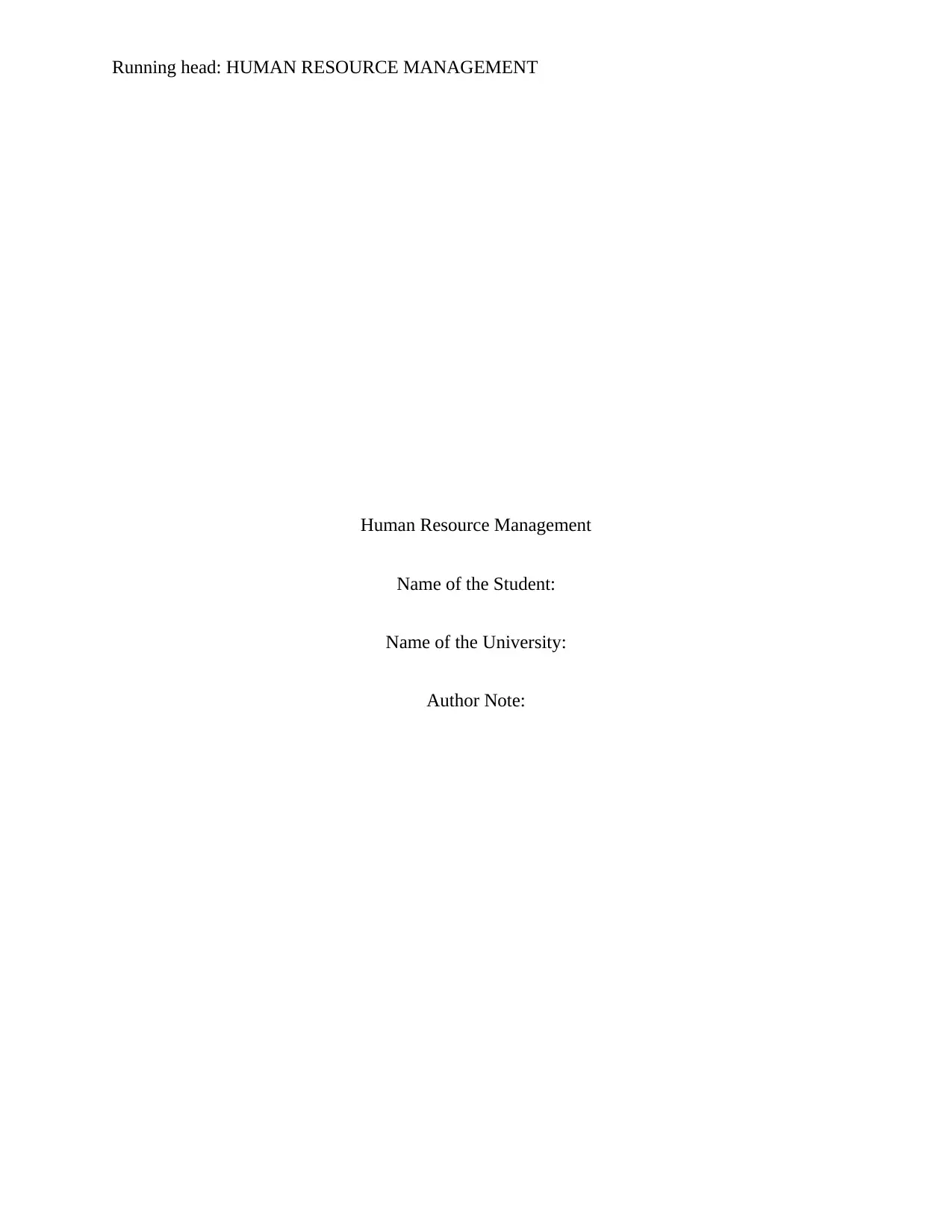
Running head: HUMAN RESOURCE MANAGEMENT
Human Resource Management
Name of the Student:
Name of the University:
Author Note:
Human Resource Management
Name of the Student:
Name of the University:
Author Note:
Paraphrase This Document
Need a fresh take? Get an instant paraphrase of this document with our AI Paraphraser
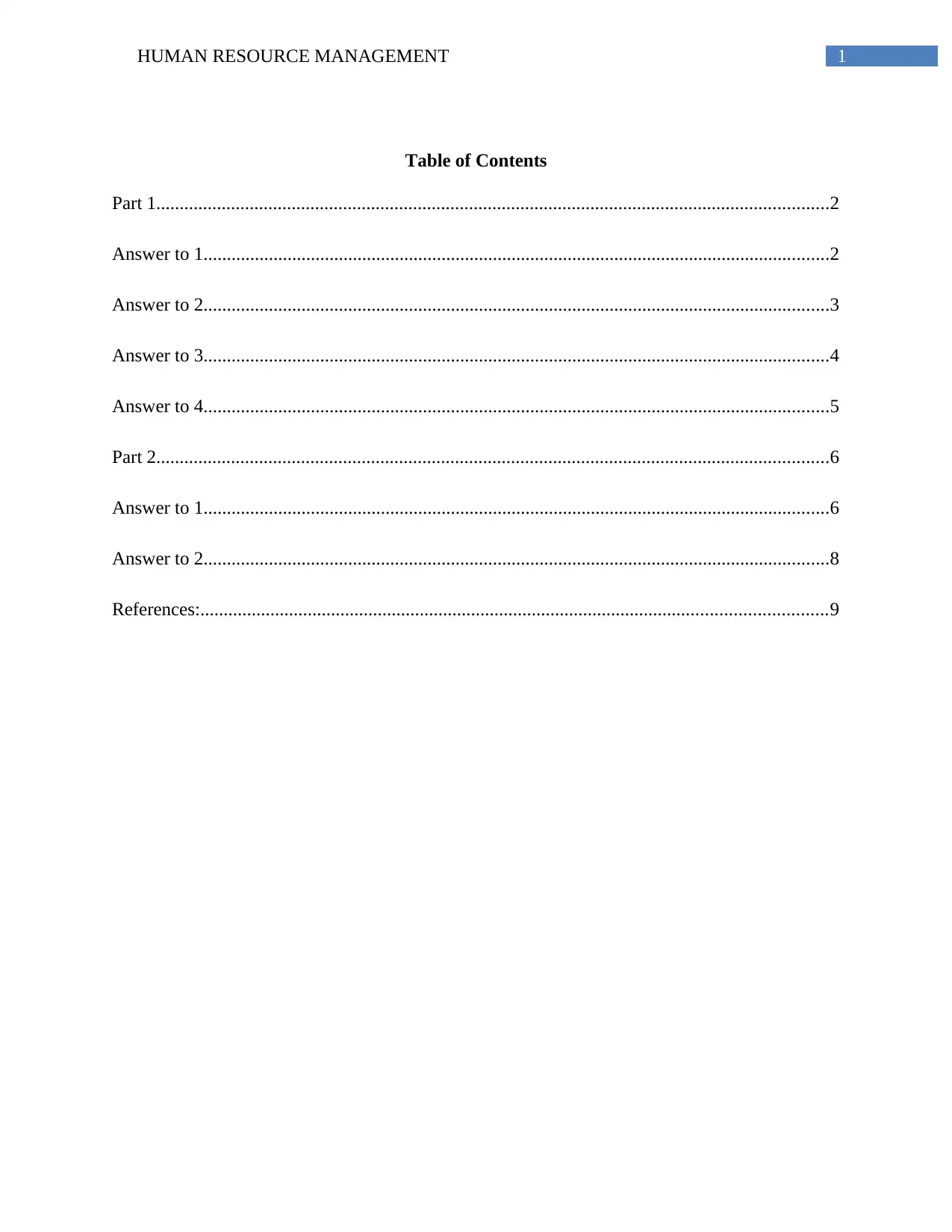
1HUMAN RESOURCE MANAGEMENT
Table of Contents
Part 1................................................................................................................................................2
Answer to 1......................................................................................................................................2
Answer to 2......................................................................................................................................3
Answer to 3......................................................................................................................................4
Answer to 4......................................................................................................................................5
Part 2................................................................................................................................................6
Answer to 1......................................................................................................................................6
Answer to 2......................................................................................................................................8
References:......................................................................................................................................9
Table of Contents
Part 1................................................................................................................................................2
Answer to 1......................................................................................................................................2
Answer to 2......................................................................................................................................3
Answer to 3......................................................................................................................................4
Answer to 4......................................................................................................................................5
Part 2................................................................................................................................................6
Answer to 1......................................................................................................................................6
Answer to 2......................................................................................................................................8
References:......................................................................................................................................9
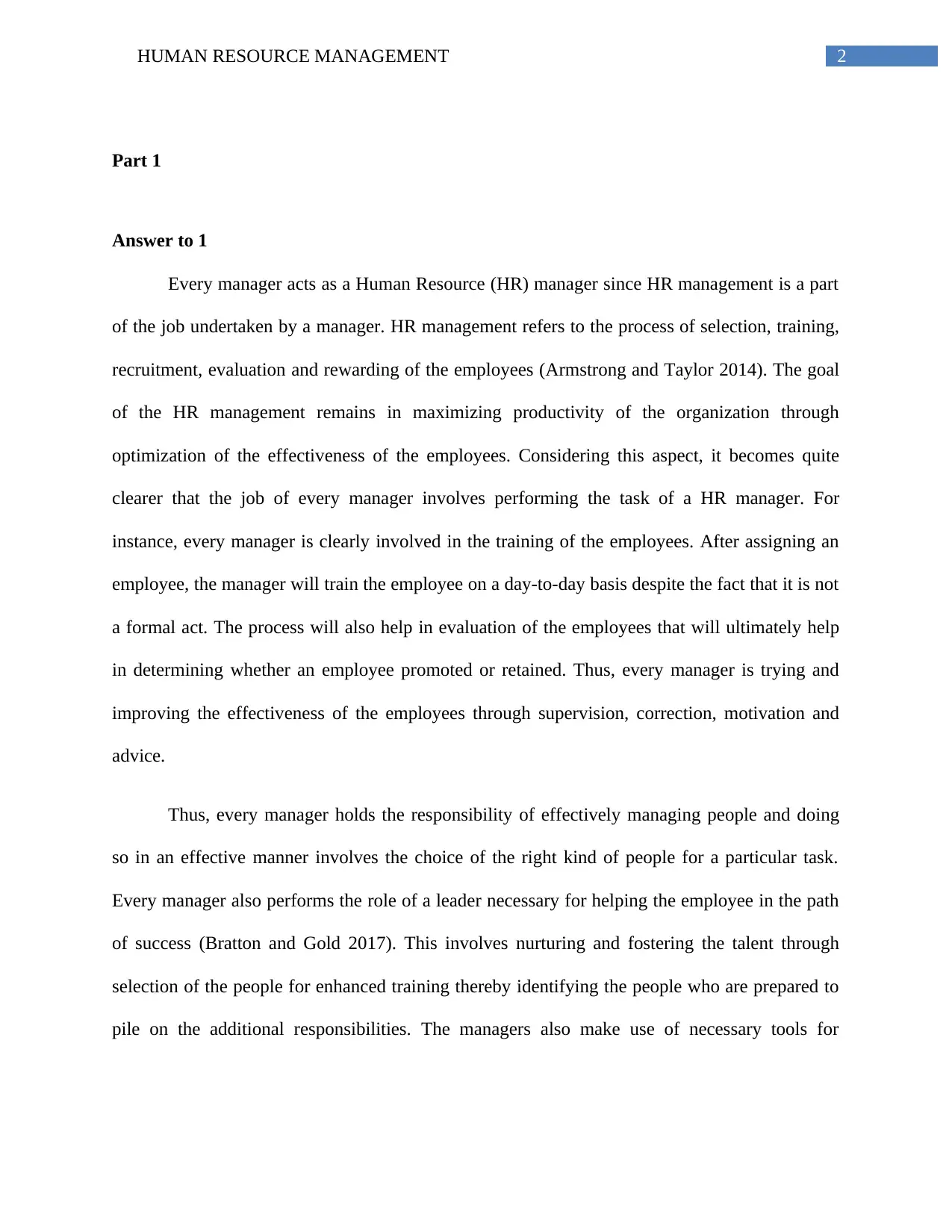
2HUMAN RESOURCE MANAGEMENT
Part 1
Answer to 1
Every manager acts as a Human Resource (HR) manager since HR management is a part
of the job undertaken by a manager. HR management refers to the process of selection, training,
recruitment, evaluation and rewarding of the employees (Armstrong and Taylor 2014). The goal
of the HR management remains in maximizing productivity of the organization through
optimization of the effectiveness of the employees. Considering this aspect, it becomes quite
clearer that the job of every manager involves performing the task of a HR manager. For
instance, every manager is clearly involved in the training of the employees. After assigning an
employee, the manager will train the employee on a day-to-day basis despite the fact that it is not
a formal act. The process will also help in evaluation of the employees that will ultimately help
in determining whether an employee promoted or retained. Thus, every manager is trying and
improving the effectiveness of the employees through supervision, correction, motivation and
advice.
Thus, every manager holds the responsibility of effectively managing people and doing
so in an effective manner involves the choice of the right kind of people for a particular task.
Every manager also performs the role of a leader necessary for helping the employee in the path
of success (Bratton and Gold 2017). This involves nurturing and fostering the talent through
selection of the people for enhanced training thereby identifying the people who are prepared to
pile on the additional responsibilities. The managers also make use of necessary tools for
Part 1
Answer to 1
Every manager acts as a Human Resource (HR) manager since HR management is a part
of the job undertaken by a manager. HR management refers to the process of selection, training,
recruitment, evaluation and rewarding of the employees (Armstrong and Taylor 2014). The goal
of the HR management remains in maximizing productivity of the organization through
optimization of the effectiveness of the employees. Considering this aspect, it becomes quite
clearer that the job of every manager involves performing the task of a HR manager. For
instance, every manager is clearly involved in the training of the employees. After assigning an
employee, the manager will train the employee on a day-to-day basis despite the fact that it is not
a formal act. The process will also help in evaluation of the employees that will ultimately help
in determining whether an employee promoted or retained. Thus, every manager is trying and
improving the effectiveness of the employees through supervision, correction, motivation and
advice.
Thus, every manager holds the responsibility of effectively managing people and doing
so in an effective manner involves the choice of the right kind of people for a particular task.
Every manager also performs the role of a leader necessary for helping the employee in the path
of success (Bratton and Gold 2017). This involves nurturing and fostering the talent through
selection of the people for enhanced training thereby identifying the people who are prepared to
pile on the additional responsibilities. The managers also make use of necessary tools for
⊘ This is a preview!⊘
Do you want full access?
Subscribe today to unlock all pages.

Trusted by 1+ million students worldwide
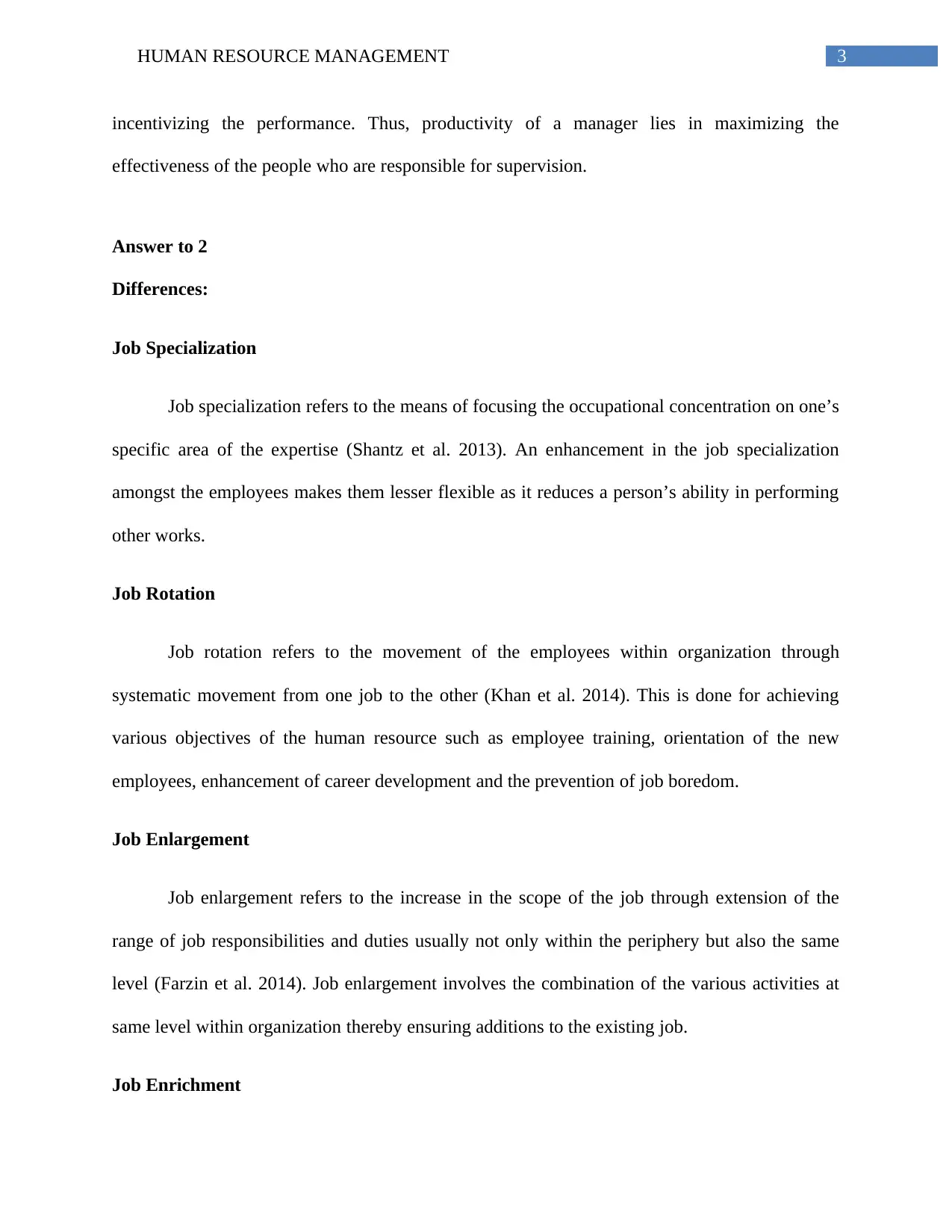
3HUMAN RESOURCE MANAGEMENT
incentivizing the performance. Thus, productivity of a manager lies in maximizing the
effectiveness of the people who are responsible for supervision.
Answer to 2
Differences:
Job Specialization
Job specialization refers to the means of focusing the occupational concentration on one’s
specific area of the expertise (Shantz et al. 2013). An enhancement in the job specialization
amongst the employees makes them lesser flexible as it reduces a person’s ability in performing
other works.
Job Rotation
Job rotation refers to the movement of the employees within organization through
systematic movement from one job to the other (Khan et al. 2014). This is done for achieving
various objectives of the human resource such as employee training, orientation of the new
employees, enhancement of career development and the prevention of job boredom.
Job Enlargement
Job enlargement refers to the increase in the scope of the job through extension of the
range of job responsibilities and duties usually not only within the periphery but also the same
level (Farzin et al. 2014). Job enlargement involves the combination of the various activities at
same level within organization thereby ensuring additions to the existing job.
Job Enrichment
incentivizing the performance. Thus, productivity of a manager lies in maximizing the
effectiveness of the people who are responsible for supervision.
Answer to 2
Differences:
Job Specialization
Job specialization refers to the means of focusing the occupational concentration on one’s
specific area of the expertise (Shantz et al. 2013). An enhancement in the job specialization
amongst the employees makes them lesser flexible as it reduces a person’s ability in performing
other works.
Job Rotation
Job rotation refers to the movement of the employees within organization through
systematic movement from one job to the other (Khan et al. 2014). This is done for achieving
various objectives of the human resource such as employee training, orientation of the new
employees, enhancement of career development and the prevention of job boredom.
Job Enlargement
Job enlargement refers to the increase in the scope of the job through extension of the
range of job responsibilities and duties usually not only within the periphery but also the same
level (Farzin et al. 2014). Job enlargement involves the combination of the various activities at
same level within organization thereby ensuring additions to the existing job.
Job Enrichment
Paraphrase This Document
Need a fresh take? Get an instant paraphrase of this document with our AI Paraphraser
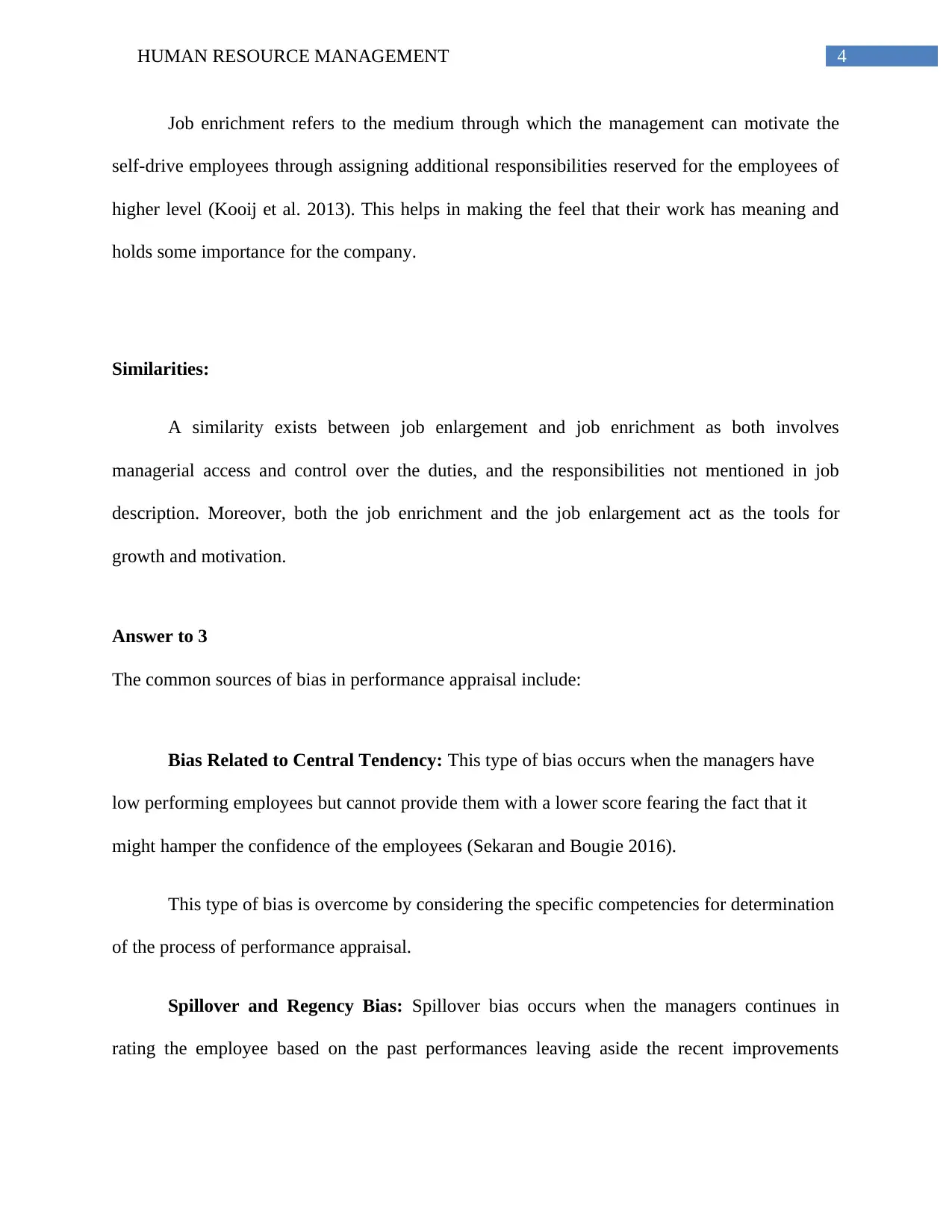
4HUMAN RESOURCE MANAGEMENT
Job enrichment refers to the medium through which the management can motivate the
self-drive employees through assigning additional responsibilities reserved for the employees of
higher level (Kooij et al. 2013). This helps in making the feel that their work has meaning and
holds some importance for the company.
Similarities:
A similarity exists between job enlargement and job enrichment as both involves
managerial access and control over the duties, and the responsibilities not mentioned in job
description. Moreover, both the job enrichment and the job enlargement act as the tools for
growth and motivation.
Answer to 3
The common sources of bias in performance appraisal include:
Bias Related to Central Tendency: This type of bias occurs when the managers have
low performing employees but cannot provide them with a lower score fearing the fact that it
might hamper the confidence of the employees (Sekaran and Bougie 2016).
This type of bias is overcome by considering the specific competencies for determination
of the process of performance appraisal.
Spillover and Regency Bias: Spillover bias occurs when the managers continues in
rating the employee based on the past performances leaving aside the recent improvements
Job enrichment refers to the medium through which the management can motivate the
self-drive employees through assigning additional responsibilities reserved for the employees of
higher level (Kooij et al. 2013). This helps in making the feel that their work has meaning and
holds some importance for the company.
Similarities:
A similarity exists between job enlargement and job enrichment as both involves
managerial access and control over the duties, and the responsibilities not mentioned in job
description. Moreover, both the job enrichment and the job enlargement act as the tools for
growth and motivation.
Answer to 3
The common sources of bias in performance appraisal include:
Bias Related to Central Tendency: This type of bias occurs when the managers have
low performing employees but cannot provide them with a lower score fearing the fact that it
might hamper the confidence of the employees (Sekaran and Bougie 2016).
This type of bias is overcome by considering the specific competencies for determination
of the process of performance appraisal.
Spillover and Regency Bias: Spillover bias occurs when the managers continues in
rating the employee based on the past performances leaving aside the recent improvements
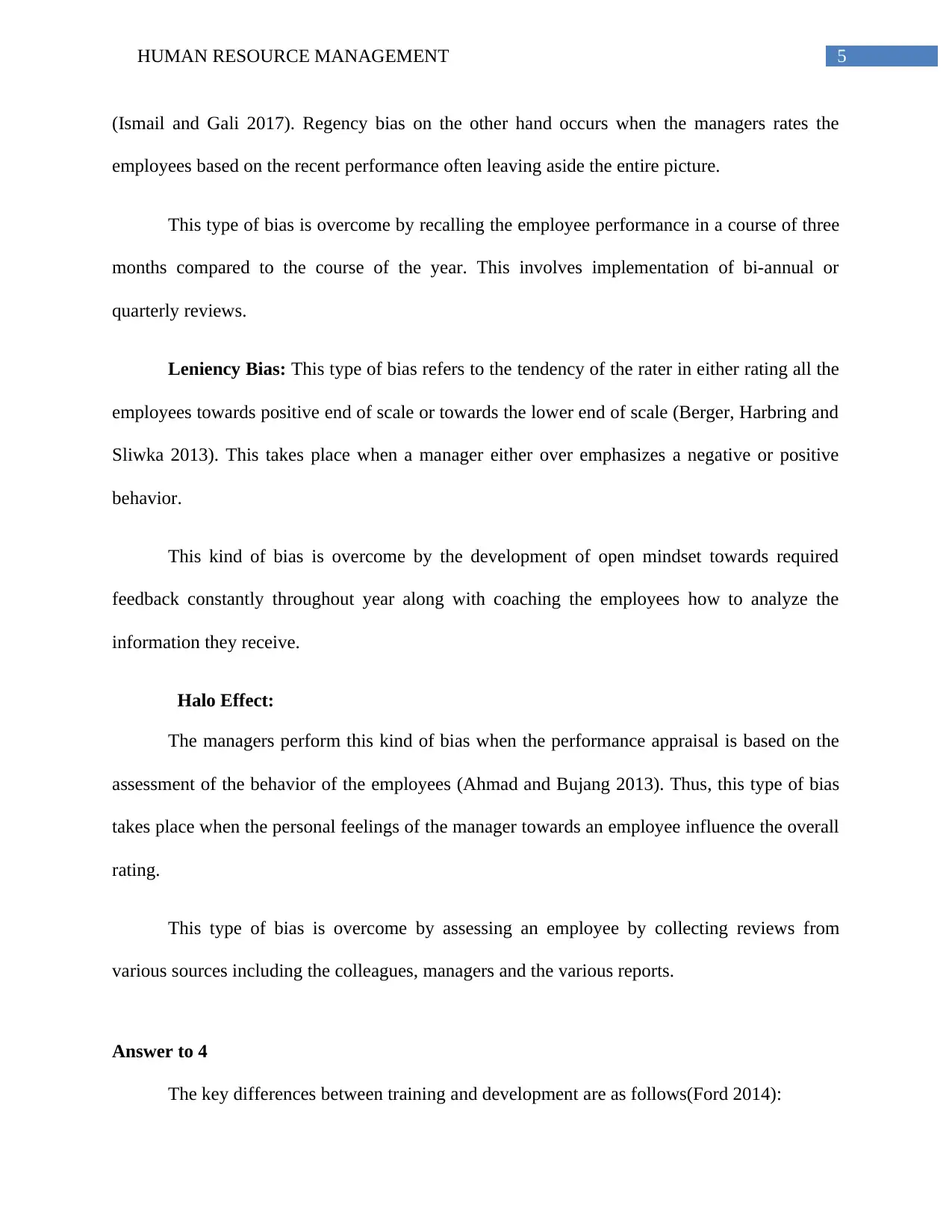
5HUMAN RESOURCE MANAGEMENT
(Ismail and Gali 2017). Regency bias on the other hand occurs when the managers rates the
employees based on the recent performance often leaving aside the entire picture.
This type of bias is overcome by recalling the employee performance in a course of three
months compared to the course of the year. This involves implementation of bi-annual or
quarterly reviews.
Leniency Bias: This type of bias refers to the tendency of the rater in either rating all the
employees towards positive end of scale or towards the lower end of scale (Berger, Harbring and
Sliwka 2013). This takes place when a manager either over emphasizes a negative or positive
behavior.
This kind of bias is overcome by the development of open mindset towards required
feedback constantly throughout year along with coaching the employees how to analyze the
information they receive.
Halo Effect:
The managers perform this kind of bias when the performance appraisal is based on the
assessment of the behavior of the employees (Ahmad and Bujang 2013). Thus, this type of bias
takes place when the personal feelings of the manager towards an employee influence the overall
rating.
This type of bias is overcome by assessing an employee by collecting reviews from
various sources including the colleagues, managers and the various reports.
Answer to 4
The key differences between training and development are as follows(Ford 2014):
(Ismail and Gali 2017). Regency bias on the other hand occurs when the managers rates the
employees based on the recent performance often leaving aside the entire picture.
This type of bias is overcome by recalling the employee performance in a course of three
months compared to the course of the year. This involves implementation of bi-annual or
quarterly reviews.
Leniency Bias: This type of bias refers to the tendency of the rater in either rating all the
employees towards positive end of scale or towards the lower end of scale (Berger, Harbring and
Sliwka 2013). This takes place when a manager either over emphasizes a negative or positive
behavior.
This kind of bias is overcome by the development of open mindset towards required
feedback constantly throughout year along with coaching the employees how to analyze the
information they receive.
Halo Effect:
The managers perform this kind of bias when the performance appraisal is based on the
assessment of the behavior of the employees (Ahmad and Bujang 2013). Thus, this type of bias
takes place when the personal feelings of the manager towards an employee influence the overall
rating.
This type of bias is overcome by assessing an employee by collecting reviews from
various sources including the colleagues, managers and the various reports.
Answer to 4
The key differences between training and development are as follows(Ford 2014):
⊘ This is a preview!⊘
Do you want full access?
Subscribe today to unlock all pages.

Trusted by 1+ million students worldwide
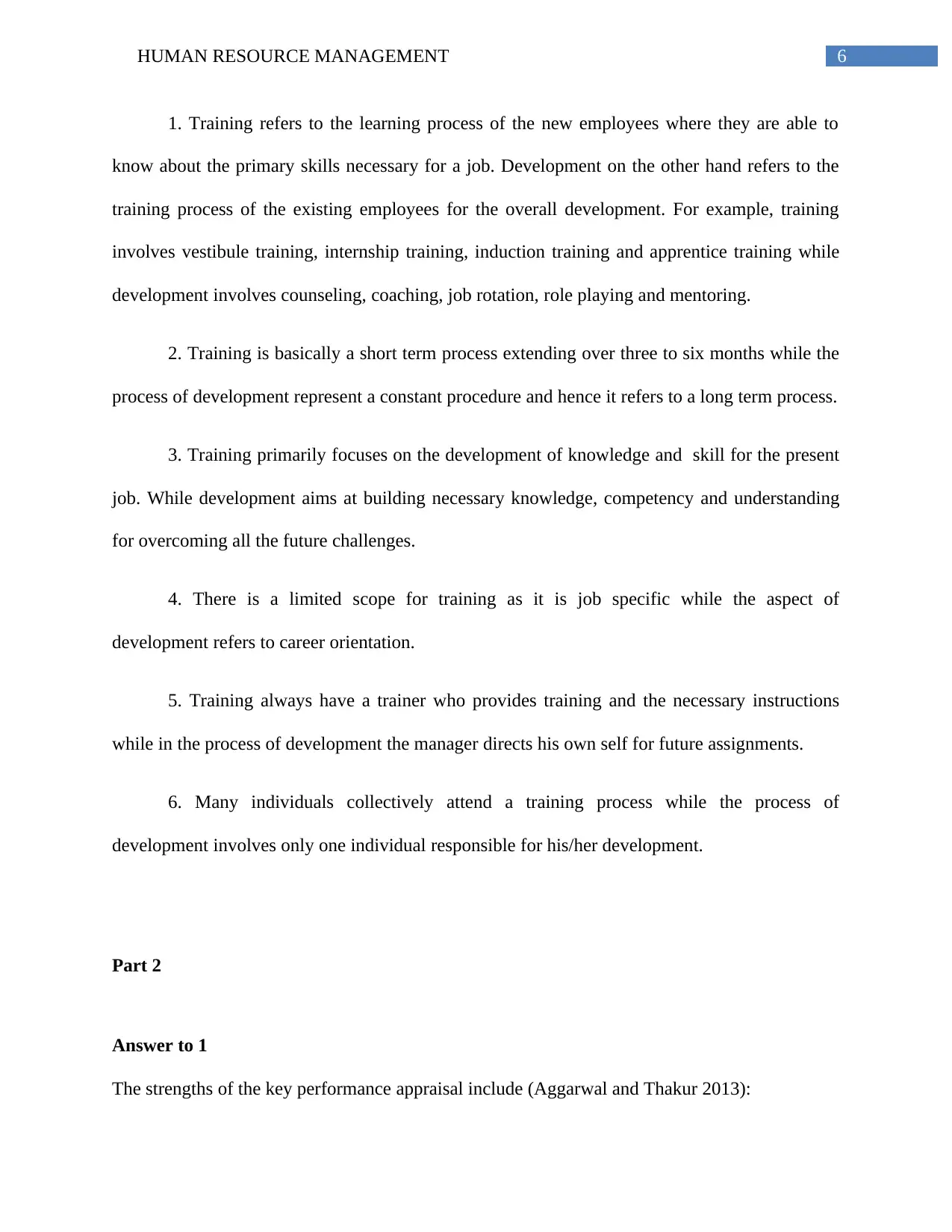
6HUMAN RESOURCE MANAGEMENT
1. Training refers to the learning process of the new employees where they are able to
know about the primary skills necessary for a job. Development on the other hand refers to the
training process of the existing employees for the overall development. For example, training
involves vestibule training, internship training, induction training and apprentice training while
development involves counseling, coaching, job rotation, role playing and mentoring.
2. Training is basically a short term process extending over three to six months while the
process of development represent a constant procedure and hence it refers to a long term process.
3. Training primarily focuses on the development of knowledge and skill for the present
job. While development aims at building necessary knowledge, competency and understanding
for overcoming all the future challenges.
4. There is a limited scope for training as it is job specific while the aspect of
development refers to career orientation.
5. Training always have a trainer who provides training and the necessary instructions
while in the process of development the manager directs his own self for future assignments.
6. Many individuals collectively attend a training process while the process of
development involves only one individual responsible for his/her development.
Part 2
Answer to 1
The strengths of the key performance appraisal include (Aggarwal and Thakur 2013):
1. Training refers to the learning process of the new employees where they are able to
know about the primary skills necessary for a job. Development on the other hand refers to the
training process of the existing employees for the overall development. For example, training
involves vestibule training, internship training, induction training and apprentice training while
development involves counseling, coaching, job rotation, role playing and mentoring.
2. Training is basically a short term process extending over three to six months while the
process of development represent a constant procedure and hence it refers to a long term process.
3. Training primarily focuses on the development of knowledge and skill for the present
job. While development aims at building necessary knowledge, competency and understanding
for overcoming all the future challenges.
4. There is a limited scope for training as it is job specific while the aspect of
development refers to career orientation.
5. Training always have a trainer who provides training and the necessary instructions
while in the process of development the manager directs his own self for future assignments.
6. Many individuals collectively attend a training process while the process of
development involves only one individual responsible for his/her development.
Part 2
Answer to 1
The strengths of the key performance appraisal include (Aggarwal and Thakur 2013):
Paraphrase This Document
Need a fresh take? Get an instant paraphrase of this document with our AI Paraphraser
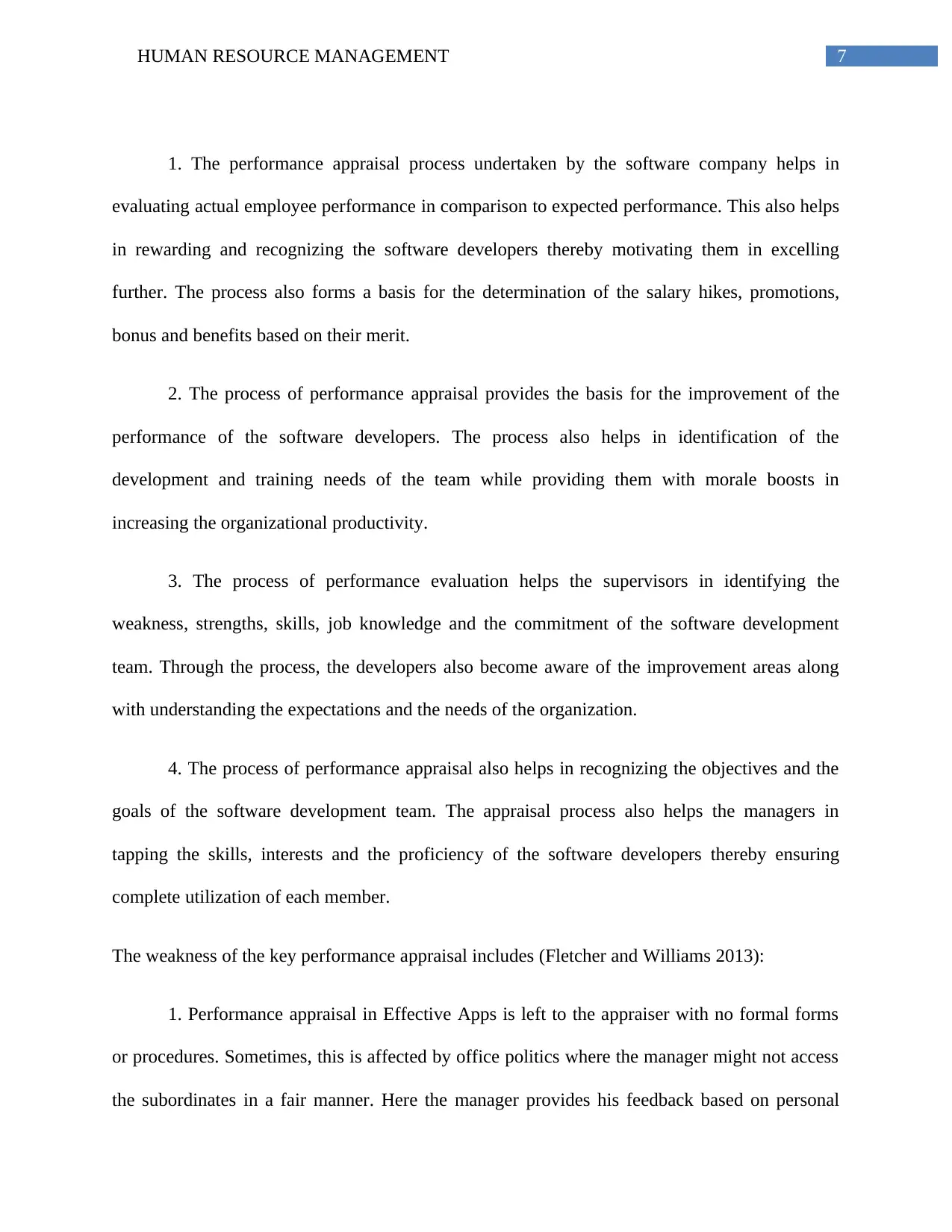
7HUMAN RESOURCE MANAGEMENT
1. The performance appraisal process undertaken by the software company helps in
evaluating actual employee performance in comparison to expected performance. This also helps
in rewarding and recognizing the software developers thereby motivating them in excelling
further. The process also forms a basis for the determination of the salary hikes, promotions,
bonus and benefits based on their merit.
2. The process of performance appraisal provides the basis for the improvement of the
performance of the software developers. The process also helps in identification of the
development and training needs of the team while providing them with morale boosts in
increasing the organizational productivity.
3. The process of performance evaluation helps the supervisors in identifying the
weakness, strengths, skills, job knowledge and the commitment of the software development
team. Through the process, the developers also become aware of the improvement areas along
with understanding the expectations and the needs of the organization.
4. The process of performance appraisal also helps in recognizing the objectives and the
goals of the software development team. The appraisal process also helps the managers in
tapping the skills, interests and the proficiency of the software developers thereby ensuring
complete utilization of each member.
The weakness of the key performance appraisal includes (Fletcher and Williams 2013):
1. Performance appraisal in Effective Apps is left to the appraiser with no formal forms
or procedures. Sometimes, this is affected by office politics where the manager might not access
the subordinates in a fair manner. Here the manager provides his feedback based on personal
1. The performance appraisal process undertaken by the software company helps in
evaluating actual employee performance in comparison to expected performance. This also helps
in rewarding and recognizing the software developers thereby motivating them in excelling
further. The process also forms a basis for the determination of the salary hikes, promotions,
bonus and benefits based on their merit.
2. The process of performance appraisal provides the basis for the improvement of the
performance of the software developers. The process also helps in identification of the
development and training needs of the team while providing them with morale boosts in
increasing the organizational productivity.
3. The process of performance evaluation helps the supervisors in identifying the
weakness, strengths, skills, job knowledge and the commitment of the software development
team. Through the process, the developers also become aware of the improvement areas along
with understanding the expectations and the needs of the organization.
4. The process of performance appraisal also helps in recognizing the objectives and the
goals of the software development team. The appraisal process also helps the managers in
tapping the skills, interests and the proficiency of the software developers thereby ensuring
complete utilization of each member.
The weakness of the key performance appraisal includes (Fletcher and Williams 2013):
1. Performance appraisal in Effective Apps is left to the appraiser with no formal forms
or procedures. Sometimes, this is affected by office politics where the manager might not access
the subordinates in a fair manner. Here the manager provides his feedback based on personal
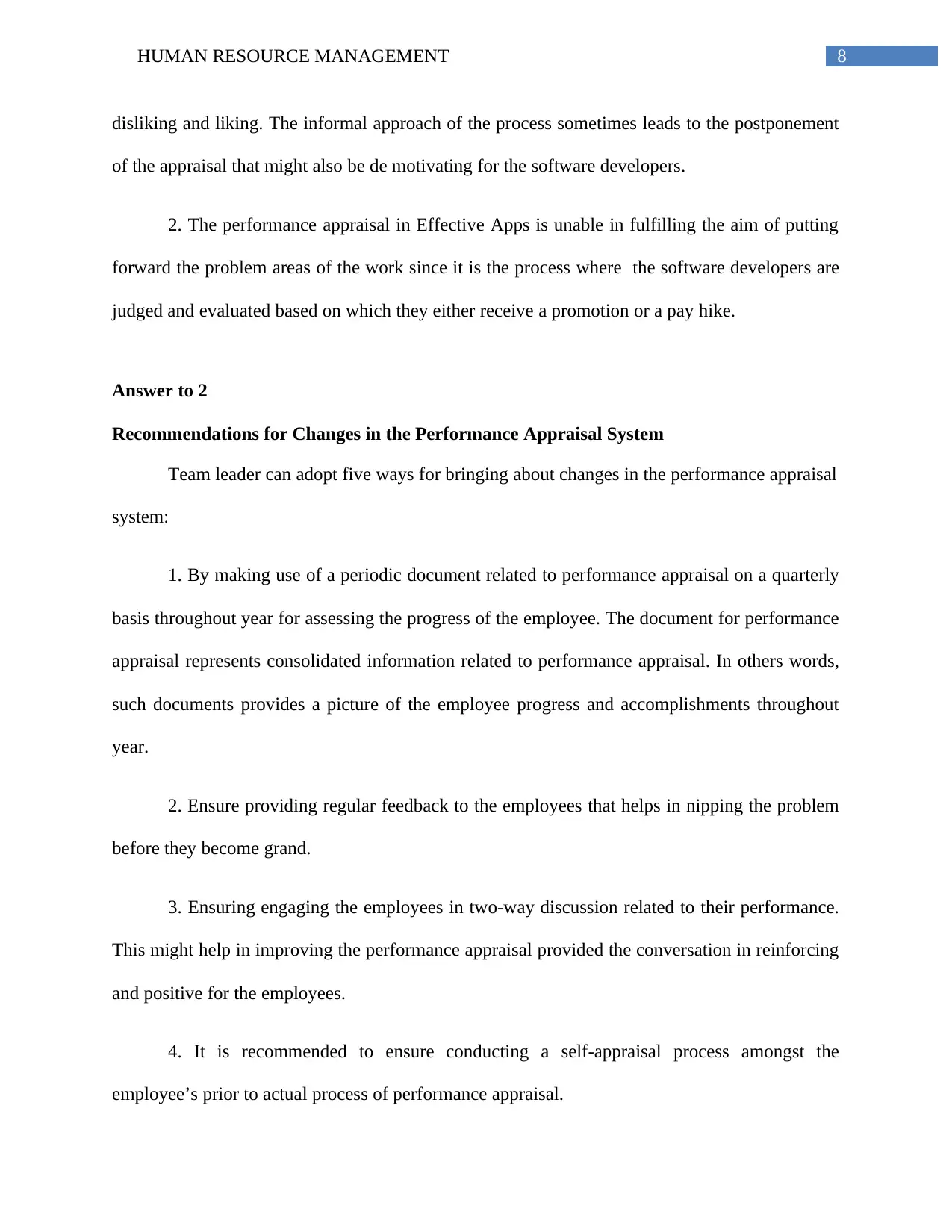
8HUMAN RESOURCE MANAGEMENT
disliking and liking. The informal approach of the process sometimes leads to the postponement
of the appraisal that might also be de motivating for the software developers.
2. The performance appraisal in Effective Apps is unable in fulfilling the aim of putting
forward the problem areas of the work since it is the process where the software developers are
judged and evaluated based on which they either receive a promotion or a pay hike.
Answer to 2
Recommendations for Changes in the Performance Appraisal System
Team leader can adopt five ways for bringing about changes in the performance appraisal
system:
1. By making use of a periodic document related to performance appraisal on a quarterly
basis throughout year for assessing the progress of the employee. The document for performance
appraisal represents consolidated information related to performance appraisal. In others words,
such documents provides a picture of the employee progress and accomplishments throughout
year.
2. Ensure providing regular feedback to the employees that helps in nipping the problem
before they become grand.
3. Ensuring engaging the employees in two-way discussion related to their performance.
This might help in improving the performance appraisal provided the conversation in reinforcing
and positive for the employees.
4. It is recommended to ensure conducting a self-appraisal process amongst the
employee’s prior to actual process of performance appraisal.
disliking and liking. The informal approach of the process sometimes leads to the postponement
of the appraisal that might also be de motivating for the software developers.
2. The performance appraisal in Effective Apps is unable in fulfilling the aim of putting
forward the problem areas of the work since it is the process where the software developers are
judged and evaluated based on which they either receive a promotion or a pay hike.
Answer to 2
Recommendations for Changes in the Performance Appraisal System
Team leader can adopt five ways for bringing about changes in the performance appraisal
system:
1. By making use of a periodic document related to performance appraisal on a quarterly
basis throughout year for assessing the progress of the employee. The document for performance
appraisal represents consolidated information related to performance appraisal. In others words,
such documents provides a picture of the employee progress and accomplishments throughout
year.
2. Ensure providing regular feedback to the employees that helps in nipping the problem
before they become grand.
3. Ensuring engaging the employees in two-way discussion related to their performance.
This might help in improving the performance appraisal provided the conversation in reinforcing
and positive for the employees.
4. It is recommended to ensure conducting a self-appraisal process amongst the
employee’s prior to actual process of performance appraisal.
⊘ This is a preview!⊘
Do you want full access?
Subscribe today to unlock all pages.

Trusted by 1+ million students worldwide
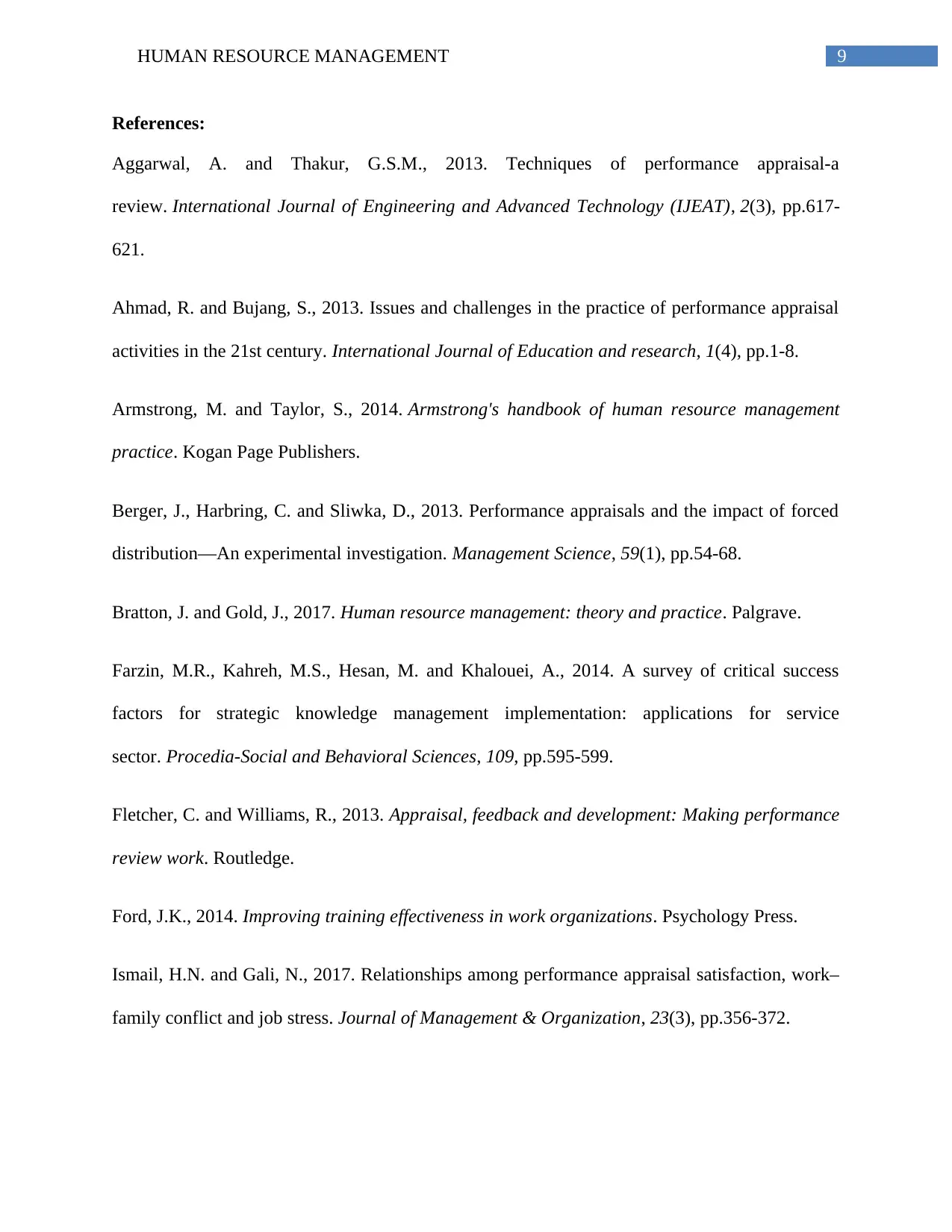
9HUMAN RESOURCE MANAGEMENT
References:
Aggarwal, A. and Thakur, G.S.M., 2013. Techniques of performance appraisal-a
review. International Journal of Engineering and Advanced Technology (IJEAT), 2(3), pp.617-
621.
Ahmad, R. and Bujang, S., 2013. Issues and challenges in the practice of performance appraisal
activities in the 21st century. International Journal of Education and research, 1(4), pp.1-8.
Armstrong, M. and Taylor, S., 2014. Armstrong's handbook of human resource management
practice. Kogan Page Publishers.
Berger, J., Harbring, C. and Sliwka, D., 2013. Performance appraisals and the impact of forced
distribution—An experimental investigation. Management Science, 59(1), pp.54-68.
Bratton, J. and Gold, J., 2017. Human resource management: theory and practice. Palgrave.
Farzin, M.R., Kahreh, M.S., Hesan, M. and Khalouei, A., 2014. A survey of critical success
factors for strategic knowledge management implementation: applications for service
sector. Procedia-Social and Behavioral Sciences, 109, pp.595-599.
Fletcher, C. and Williams, R., 2013. Appraisal, feedback and development: Making performance
review work. Routledge.
Ford, J.K., 2014. Improving training effectiveness in work organizations. Psychology Press.
Ismail, H.N. and Gali, N., 2017. Relationships among performance appraisal satisfaction, work–
family conflict and job stress. Journal of Management & Organization, 23(3), pp.356-372.
References:
Aggarwal, A. and Thakur, G.S.M., 2013. Techniques of performance appraisal-a
review. International Journal of Engineering and Advanced Technology (IJEAT), 2(3), pp.617-
621.
Ahmad, R. and Bujang, S., 2013. Issues and challenges in the practice of performance appraisal
activities in the 21st century. International Journal of Education and research, 1(4), pp.1-8.
Armstrong, M. and Taylor, S., 2014. Armstrong's handbook of human resource management
practice. Kogan Page Publishers.
Berger, J., Harbring, C. and Sliwka, D., 2013. Performance appraisals and the impact of forced
distribution—An experimental investigation. Management Science, 59(1), pp.54-68.
Bratton, J. and Gold, J., 2017. Human resource management: theory and practice. Palgrave.
Farzin, M.R., Kahreh, M.S., Hesan, M. and Khalouei, A., 2014. A survey of critical success
factors for strategic knowledge management implementation: applications for service
sector. Procedia-Social and Behavioral Sciences, 109, pp.595-599.
Fletcher, C. and Williams, R., 2013. Appraisal, feedback and development: Making performance
review work. Routledge.
Ford, J.K., 2014. Improving training effectiveness in work organizations. Psychology Press.
Ismail, H.N. and Gali, N., 2017. Relationships among performance appraisal satisfaction, work–
family conflict and job stress. Journal of Management & Organization, 23(3), pp.356-372.
Paraphrase This Document
Need a fresh take? Get an instant paraphrase of this document with our AI Paraphraser
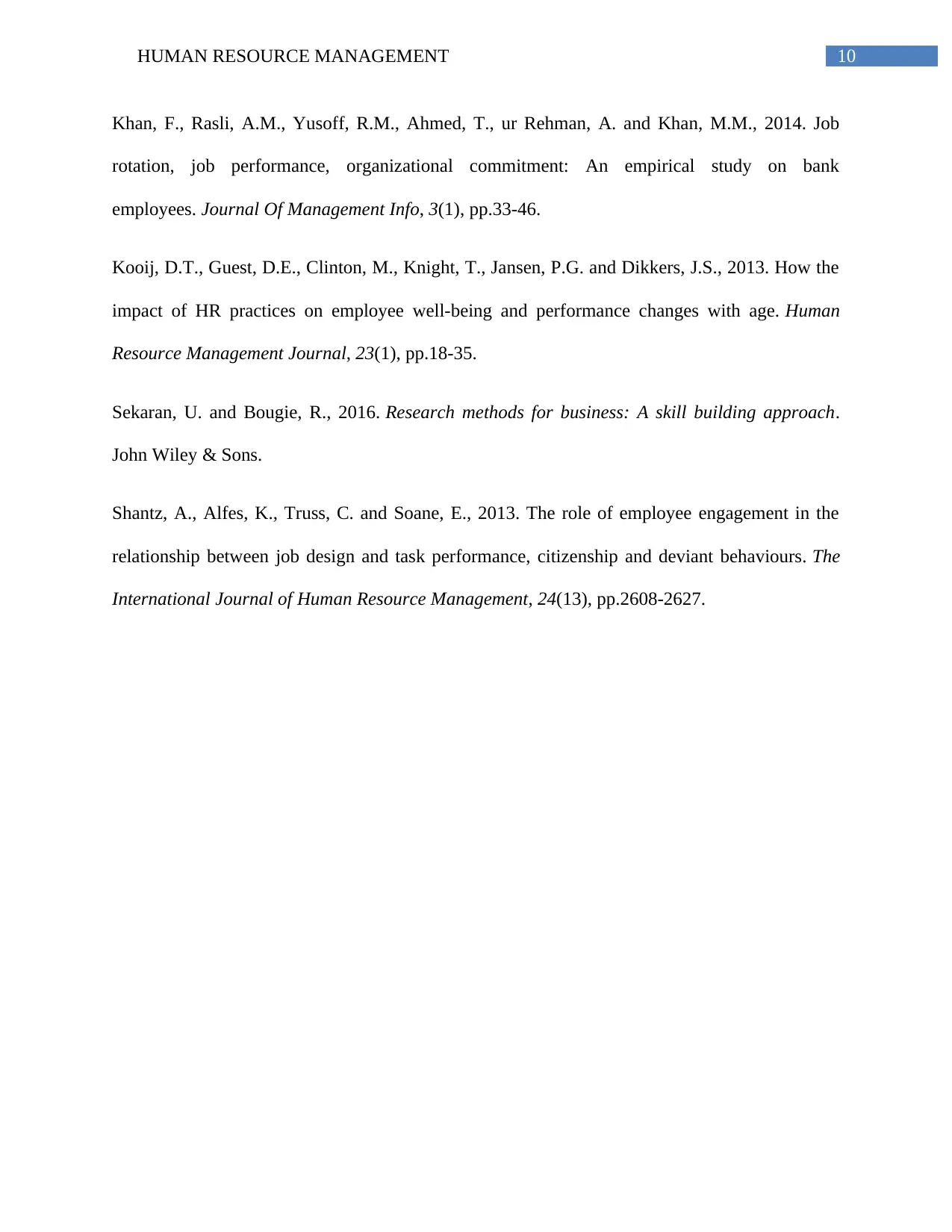
10HUMAN RESOURCE MANAGEMENT
Khan, F., Rasli, A.M., Yusoff, R.M., Ahmed, T., ur Rehman, A. and Khan, M.M., 2014. Job
rotation, job performance, organizational commitment: An empirical study on bank
employees. Journal Of Management Info, 3(1), pp.33-46.
Kooij, D.T., Guest, D.E., Clinton, M., Knight, T., Jansen, P.G. and Dikkers, J.S., 2013. How the
impact of HR practices on employee well‐being and performance changes with age. Human
Resource Management Journal, 23(1), pp.18-35.
Sekaran, U. and Bougie, R., 2016. Research methods for business: A skill building approach.
John Wiley & Sons.
Shantz, A., Alfes, K., Truss, C. and Soane, E., 2013. The role of employee engagement in the
relationship between job design and task performance, citizenship and deviant behaviours. The
International Journal of Human Resource Management, 24(13), pp.2608-2627.
Khan, F., Rasli, A.M., Yusoff, R.M., Ahmed, T., ur Rehman, A. and Khan, M.M., 2014. Job
rotation, job performance, organizational commitment: An empirical study on bank
employees. Journal Of Management Info, 3(1), pp.33-46.
Kooij, D.T., Guest, D.E., Clinton, M., Knight, T., Jansen, P.G. and Dikkers, J.S., 2013. How the
impact of HR practices on employee well‐being and performance changes with age. Human
Resource Management Journal, 23(1), pp.18-35.
Sekaran, U. and Bougie, R., 2016. Research methods for business: A skill building approach.
John Wiley & Sons.
Shantz, A., Alfes, K., Truss, C. and Soane, E., 2013. The role of employee engagement in the
relationship between job design and task performance, citizenship and deviant behaviours. The
International Journal of Human Resource Management, 24(13), pp.2608-2627.
1 out of 11
Related Documents
Your All-in-One AI-Powered Toolkit for Academic Success.
+13062052269
info@desklib.com
Available 24*7 on WhatsApp / Email
![[object Object]](/_next/static/media/star-bottom.7253800d.svg)
Unlock your academic potential
Copyright © 2020–2025 A2Z Services. All Rights Reserved. Developed and managed by ZUCOL.





